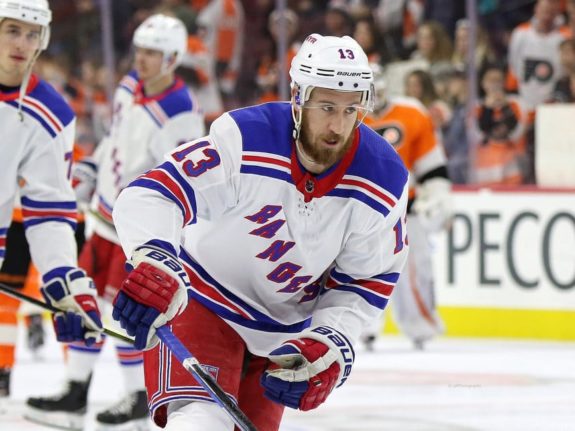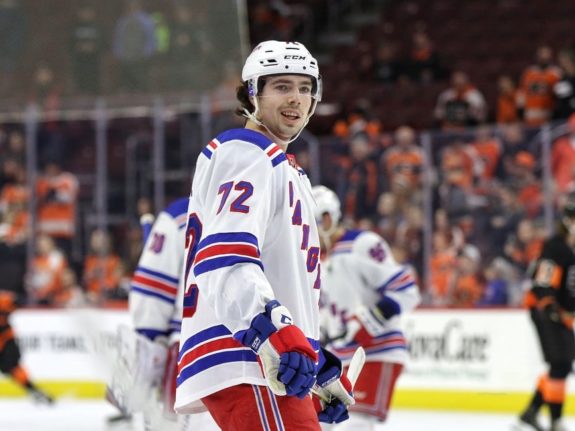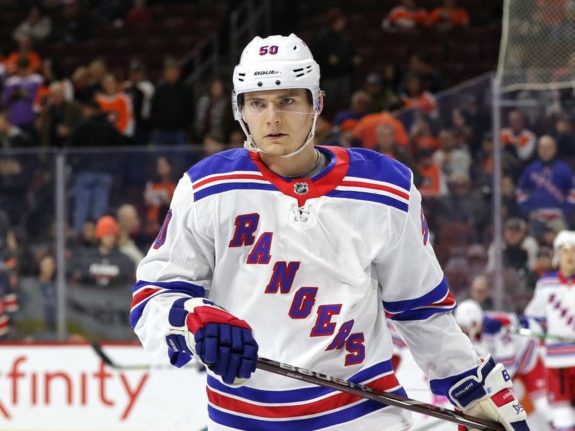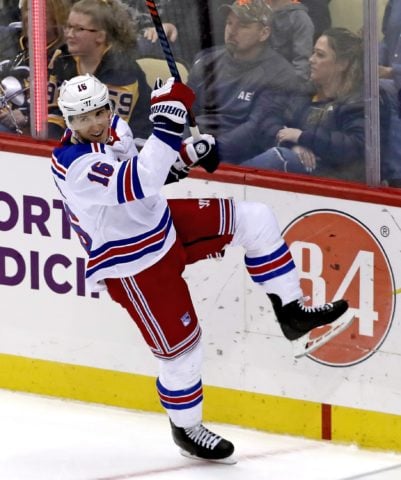Kevin Hayes thinks the New York Rangers are going to miss him. In at least one aspect of the game, it won’t take long to find out if he’s right.
The former Rangers center, now a member of the rival Philadelphia Flyers, sounded as if he still misses Broadway in an interview last week, more than somewhat lamenting the end of his five-year tenure with the Rangers in the form of February’s trade to the Winnipeg Jets.
“They chose to get rid of me and (winger Jimmy Vesey), but that’s their decision,” Hayes said. “I’m sure it’ll come back to them, we’ll find out.”
The Rangers will probably know almost immediately if Hayes is correct when it comes to one key area. As the Blueshirts’ No. 2 center last season, Hayes was relied on by coach David Quinn as one of two primary options to take faceoffs in the defensive zone. Hayes made 46.8 percent of his starts in the D-zone, trailing top center Mike Zibanejad’s 54.0 mark.

Substandard at the dot in his first three NHL seasons, when he won under 40 percent of his draws twice, Hayes slowly transformed himself into a tougher matchup on faceoffs. He won better than 50 percent twice over the past three seasons, posting a career-best mark of 51.6 percent in 2018-19.
Simply put, the Rangers are going to have to fill that role quickly. And therein lies one of the numerous pitfalls of their youthful personnel situation in the middle: Center is a complex position that requires much more than just offensive production.
Rangers’ Youthful Centers Face Pressure to Win Draws
Amid the excitement over young Blueshirts pivots Filip Chytil, Lias Andersson and Brett Howden, the question must be asked: Who, if anyone, will emerge to assume Hayes’ role as a dependable option to win crucial faceoffs in the Rangers’ zone?
“I’d like to give these guys some stability and put them in a position,” Quinn said. “But when you look at the league, and you have high-end players, when they get into the league at a young age, they’re all centers. A lot of them are asked to play the wing early on in their career, and then they learn to play the middle because it’s such a demanding position.”
Hayes’ strong performance on faceoffs last season helped save the Rangers from being the worst team in the league at the dot. They ranked second-to-last with a 46.9 win percentage, their lowest mark in six seasons but only the most extreme example of a problem that has plagued the club throughout that time.
Since winning 50 percent of draws to rank 16th in the league in 2012-13, the Rangers have failed to reach the break-even mark again, never finishing higher than 20th in that span. That includes a 46.7 percentage in 2014-15, the season they won the Presidents’ Trophy.

That the Rangers weren’t adversely affected by this long-term failure to dominate puck possession off of faceoffs – and in fact generally thrived despite it during that period – might speak to the brilliance of a certain future Hall of Fame goaltender. Henrik Lundqvist’s time as the Rangers’ backbone superstar, however, is nearing its end. Accordingly, coach David Quinn has to be hoping that at least one of his three kid centers, none of them over the age of 21, will emerge as a top faceoff man as his team rebuilds.
“These young guys playing the middle, it’s very and up and down, it’s very inconsistent,” Quinn said. “So there might be times when all three of them are playing center if they’re all on the roster depending on how they’re playing. Matchups may come into it. What everybody has to understand is that so much goes into these decisions.
“And you want to put these guys in a situation to succeed, too.”
Zibanejad is Rangers’ Only Proven Option at Faceoff Dot
Zibanejad, the rising star coming off a career season, has been mostly proficient on draws throughout his seven-year career. He won 51 percent in 2017-18 and 49.7 last season. He also can’t take every faceoff.
Howden did show promise on faceoffs last season in by far the biggest sample size of the three young pivots. Howden, who made the team as a rookie third-line center out of training camp, took 729 draws and won 48.4 percent.
The numbers weren’t as encouraging for Chytil or Andersson. Chytil prevailed on only 38.9 percent of his 175 faceoffs while Andersson won 44.2 percent of his 190. Those numbers will need to significantly improve for the Rangers to have a viable situation at the dot in 2019-20.

There are veteran fallback options. Ryan Strome won better than 47 percent of his faceoffs the past two seasons, and Vladislav Namestnikov is a natural center who could slide off the wing into the middle if needed. Namestnikov, however, hasn’t proven particularly effective on draws in his six seasons (44.7), and having to rely heavily on either player wouldn’t serve the Rangers well long-term.
Hype aside, this season remains a developmental one for the Rangers. Strome and Namestnikov are unlikely to be part of the future, their contracts expiring after this season. If Quinn needs to give extensive time to either player in order to stabilize the middle, that could potentially mean a lack of invaluable reps for deserving young forwards.
Quinn Doesn’t Want to Fall Back on Strome, Namestnikov
Ideally, Quinn will be able to pencil in Zibanejad, Chytil, Howden and Andersson on a nightly basis with Strome and Namestnikov as veteran depth and insurance, while slowly feeding minutes to players such as rookie wingers Kaapo Kakko and Vitali Kravtsov, depending on how they advance.
A disaster at the dot that requires Strome or Namestnikov to step in at center, however, could force at least Chytil – who’s struggled through an unimpressive training camp – and possibly the other centers to the wings in order to keep them in the lineup. That wouldn’t represent the Rangers’ ideal configuration and would mean fewer minutes for young players.

If that turns out to be the case, so be it. The growth process for young players can often go sideways before it trends upward again. The Rangers, though, would love to at least see signs that their young centermen have the chance to become dependable players at the faceoff circle – much as old friend Hayes did over time.
If some degree of uncertainty in the middle comes to pass this season, Hayes will have been proven right – at least in the short term. As the Blueshirts continue to revamp their center corps, they’re hoping that his words don’t prove to be prophetic over the long haul.